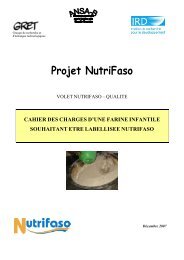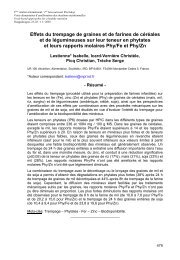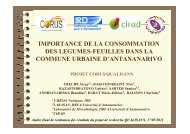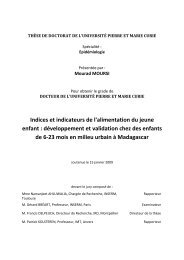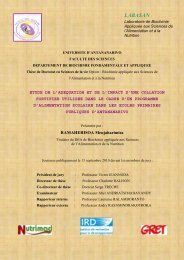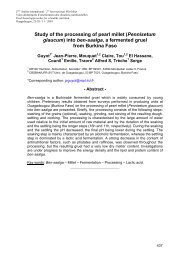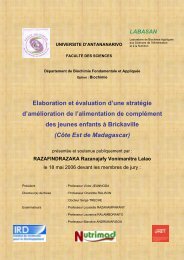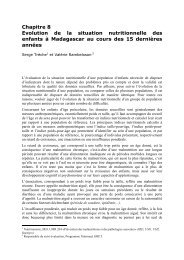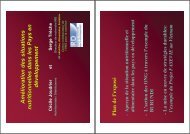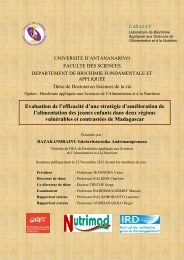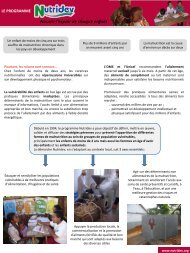THESE UNIQUE El Hassane Kéhien-Piho TOU - Nutridev
THESE UNIQUE El Hassane Kéhien-Piho TOU - Nutridev
THESE UNIQUE El Hassane Kéhien-Piho TOU - Nutridev
Create successful ePaper yourself
Turn your PDF publications into a flip-book with our unique Google optimized e-Paper software.
Projet d’article<br />
Preliminary characterization of lactic acid bacteria from pearl millet fermented pastes used<br />
for the preparation of ben-saalga, a traditional burkinabe gruel used as complementary<br />
food for young children<br />
E. H. Tou 1, 2 , C. Mouquet-Rivier 1, 3 , S. Kéléké 4 , A. S. Traoré 1 , S. Trèche 3 , J. P. Guyot 3<br />
1 UR106 « Nutrition, Alimentation, Sociétés », Institut de Recherche pour le Développement<br />
(IRD) 01 BP 182, Ouagadougou, Burkina Faso<br />
2 Université de Ouagadougou /UFR-SVT/ CRSBAN, Burkina Faso<br />
3 UR106 « Nutrition, Alimentation, Sociétés », Institut de Recherche pour le Développement<br />
(IRD), Montpellier, France<br />
4 EPRAN (Equipe Pluridisciplinaire de Recherche en Alimentation et Nutrition) Pointe-Noire<br />
/Congo<br />
* Corresponding author: E-mail address: jpguyot@mpl.ird.fr (J.P. Guyot)<br />
Abbreviated running title: lactic acid bacteria of ben-saalga<br />
Abstract<br />
The current work was performed in the frame<br />
of a wide study with the aim to assess the<br />
microbial diversity of pearl millet fermented<br />
pastes contributing to the ben-saalga stability<br />
and safety. The samples have been taken<br />
from twelve traditional small-producing units<br />
of ben-saalga. The isolated strains were<br />
tested according to their phenotypic<br />
characteristics (morphology, Gram reaction,<br />
catalase activity, biochemical profiles by API<br />
50 CHL strips and metabolic type by HPLC).<br />
The numeration of lactic acid bacteria (LAB)<br />
from the pastes highlighted that LABs are the<br />
dominant microorganisms of the ben-saalga<br />
microbiota. LAB counts in the pastes vary<br />
from 7.5 to 8.5 log CFU/g dry weight.<br />
Isolated strains of LAB (presumptively)<br />
represented 92% of the microbial community.<br />
Results of metabolic type of LABs based on<br />
HPLC determinations revealed that 58% were<br />
homofermentative and based on<br />
morphological observation 80% were<br />
lactobacilli. In addition, 57 and 69% of LABs<br />
can ferment melibiose and raffinose (αgalactoside)<br />
respectively, and 100, 100, 72<br />
and 57% fermented glucose and fructose,<br />
maltose, sucrose, respectively. Only one<br />
strain fermented starch. The<br />
heterofermentative Lactobacillus fermentumlike<br />
(i.e. Lb fermentum and Lb cellobiosus)<br />
are the most represented lactic acid bacteria<br />
72



